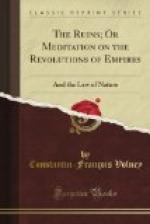“On the other hand, the sacred and mythological traditions of preceding times had spread through all Asia a dogma perfectly analogous. The cry there was a great mediator, a final judge, a future saviour, a king, god, conqueror and legislator, who was to restore the golden age upon earth,* to deliver it from the dominion of evil, and restore men to the empire of good, peace, and happiness. The people seized and cherished these ideas with so much the more avidity, as they found in them a consolation under that deplorable state of suffering into which they had been plunged by the devastations of successive conquests, and the barbarous despotism of their governments. This conformity between the oracles of different nations, and those of the prophets, excited the attention of the Jews; and doubtless the prophets had the art to compose their descriptions after the style and genius of the sacred books employed in the Pagan mysteries. There was therefore a general expectation in Judea of a great ambassador, a final Saviour; when a singular circumstance determined the epoch of his coming.
* This is the reason of the application of the many Pagan oracles to Jesus, and particularly the fourth eclogue of Virgil, and the Sybilline verses so celebrated among the ancients.
“It is found in the sacred books of the Persians and Chaldeans, that the world, composed of a total revolution of twelve thousand, was divided into two partial revolutions; one of which, the age and reign of good, terminated in six thousand; the other, the age and reign of evil, was to terminate in six thousand more.
“By these records, the first authors had understood the annual revolution of the great celestial orb called the world, (a revolution composed of twelve months or signs, divided each into a thousand parts), and the two systematic periods, of winter and summer, composed each of six thousand. These expressions, wholly equivocal and badly explained, having received an absolute and moral, instead of a physical and astrological sense, it happened that the annual world was taken for the secular world, the thousand of the zodiacal divisions, for a thousand of years; and supposing, from the state of things, that they lived in the age of evil, they inferred that it would end with the six thousand pretended years.*
* We have already seen this tradition current among the Tuscans; it was disseminated through most nations, and shows us what we ought to think of all the pretended creations and terminations of the world, which are merely the beginnings and endings of astronomical periods invented by astrologers. That of the year or solar revolution, being the most simple and perceptible, served as a model to the rest, and its comparison gave rise to the most whimsical ideas. Of this description is the idea of the four ages of the world among the Indians. Originally these four ages were merely the four seasons; and as each season was under




